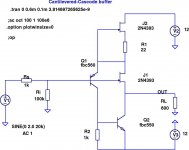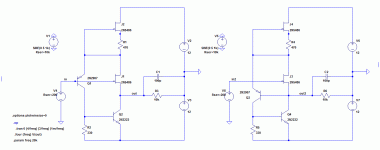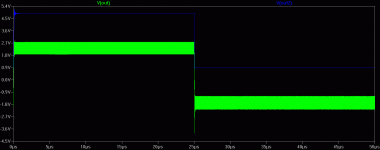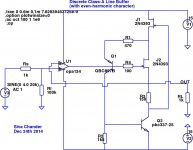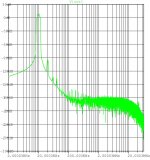The purpose of this thread is to discuss the Cantilevered-Cascode Buffer aka LinuxBuffer, a simple high-performance voltage-follower/buffer. Anything related to this buffer and variants may be posted here. Please also post links here to previous postings on the subject. The intent is to declutter the Discrete Opamp Open Design thread.
Got performance FFT data? And, can it be made to drive 30 Ohms... how? For driving low Z headphones.
And, what is the explanation on how it works?
Thx - Richard
And, what is the explanation on how it works?
Thx - Richard
A brief explanation of how it works was posted earlier at the Discrete Opamp Open Design thread: the main idea is to operate the lower JFET at nearly constant Id, Vds and Vgs; almost all of the load current swing occurs in the lower NPN, outside the direct signal path.
It's essentially the same circuit as Steven's 'Constans'. See post #13 here and the discussion that follows:
http://www.diyaudio.com/forums/solid-state/68572-const-voltage-const-current-output-fet.html
Edit: also just found a JFET version (post 6): http://www.diyaudio.com/forums/solid-state/70745-simple-low-distortion-jfet-buffer.html#post803157
http://www.diyaudio.com/forums/solid-state/68572-const-voltage-const-current-output-fet.html
Edit: also just found a JFET version (post 6): http://www.diyaudio.com/forums/solid-state/70745-simple-low-distortion-jfet-buffer.html#post803157
Last edited:
It's essentially the same circuit as Steven's 'Constans'. See post #13 here and the discussion that follows:
http://www.diyaudio.com/forums/solid-state/68572-const-voltage-const-current-output-fet.html
Edit: also just found a JFET version (post 6): http://www.diyaudio.com/forums/solid-state/70745-simple-low-distortion-jfet-buffer.html#post803157
These do appear to be interesting variations on a White follower, with either straight or folded cascoding.
It's essentially the same circuit as Steven's 'Constans'. See post #13 here and the discussion that follows:
http://www.diyaudio.com/forums/solid-state/68572-const-voltage-const-current-output-fet.html
Edit: also just found a JFET version (post 6): http://www.diyaudio.com/forums/solid-state/70745-simple-low-distortion-jfet-buffer.html#post803157
The idea is similar, but there's a subtle difference in the topology that makes a huge performance difference. That buffer references the base of the cantilever PNP to the output (emitter/source), while mine references it to the *input* (base/gate).
While it looks similar, that buffer needs dominant-pole compensation for stability, which limits BW. Mine requires little or no compensation - BW is limited by the devices alone.
While it looks similar, that buffer needs dominant-pole compensation for stability, which limits BW. Mine requires little or no compensation - BW is limited by the devices alone.
That is a hall-mark of the current-mode feedback circuits, as well. No additional Cdom added for stability. How is this circuit like a current-mode feedback buffer?
The idea is similar, but there's a subtle difference in the topology that makes a huge performance difference. That buffer references the base of the cantilever PNP to the output (emitter/source), while mine references it to the *input* (base/gate).
While it looks similar, that buffer needs dominant-pole compensation for stability, which limits BW. Mine requires little or no compensation - BW is limited by the devices alone.
I've just tried them both in LTspice using transistor models that come with the software - schematic and 20kHz square wave attached. The green trace is the Linuxbuffer and the blue Constans. Using these models and 100pF load capacitance, the Linuxbuffer oscillates at a lower source impedance than the Constans. Caution may still be required.
Attachments
More similar design ideas published by Dimitry D. in EDN July 19, 2012.
jFET Follower Amp Distortion Cancellation.
-RNM
jFET Follower Amp Distortion Cancellation.
-RNM
More similar design ideas published by Dimitry D. in EDN July 19, 2012.
jFET Follower Amp Distortion Cancellation.
That actually appears to be a JFET-input version of a 4-BJT buffer that I posted here more than a year ago, only to discover that similar ideas were the subject of patents issued to Pioneer, Japan in the late '70s.
Would you dig that up (yr ago) and post it here? This can be the place to go to when exploring all such topologies and its variations and forms. Thx -RNM
That actually appears to be a JFET-input version of a 4-BJT buffer that I posted here more than a year ago, only to discover that similar ideas were the subject of patents issued to Pioneer, Japan in the late '70s.
The buffer which you posted a year ago is a copy of Pioneer 1980 SLC. I added something to SLC and reduce distortion 20+dB. The proper credit was given to SLC. I will be glad to give a credit to your circuit as well. Unfortunately Pioneer is 20 years ahead.
Another variant/elaboration of the Cantilevered Cascode Buffer - the upper JFET is no longer a CCS, but is biased more like a Cascode. The net effect is to give a predominantly even-harmonic distortion character at the output - H2 is preserved, while H3 and the odd harmonics are attenuated.
It seems to work for a fairly wide range of loads and opamps, so it's not a simulation modelling artifact alone. It will also work with other JFETs, but R3 needs to be tweaked to get this distortion characteristic - R3 ~= 1/Yfs is a reasonable starting point. R4 is a gate stopper to keep LTSpice contented. R1 and R2 can be varied, but it has some impact on stability and sonics. Slow opamps like TL071, NE5532, OPA134, etc. are much more stable in this circuit.
It seems to work for a fairly wide range of loads and opamps, so it's not a simulation modelling artifact alone. It will also work with other JFETs, but R3 needs to be tweaked to get this distortion characteristic - R3 ~= 1/Yfs is a reasonable starting point. R4 is a gate stopper to keep LTSpice contented. R1 and R2 can be varied, but it has some impact on stability and sonics. Slow opamps like TL071, NE5532, OPA134, etc. are much more stable in this circuit.
Attachments
- Status
- Not open for further replies.
- Home
- Source & Line
- Analog Line Level
- Cantilevered-Cascode Buffer (CCB) aka LinuxBuffer
